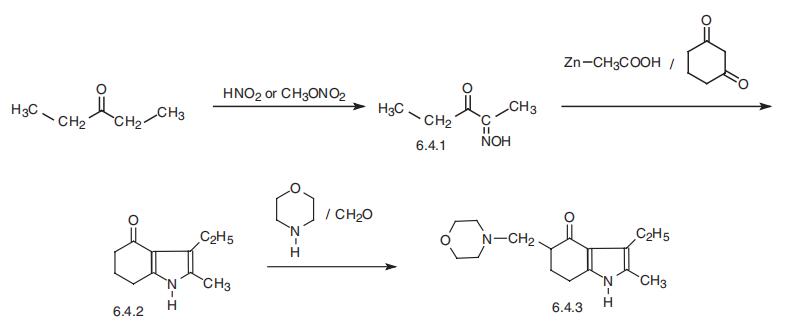| Identification | More | [Name]
3-Ethyl-2-methyl-5-(morpholin-4-ylmethyl)-1,5,6,7-tetrahydroindol-4-one | [CAS]
7416-34-4 | [Synonyms]
MOLINDONE
3-ethyl-1,5,6,7-tetrahydro-2-methyl-5-(4-morpholinylmethyl)-4h-indol-4-on
3-ethyl-1,5,6,7-tetrahydro-2-methyl-5-(4-morpholinylmethyl)-4h-indol-4-one
3-Ethyl-2-methyl-6-(4-morpholinylmethyl)-1,5,6,7-tetrahydro-4H-indol-4-one
3-ethyl-6,7-dihydro-2-methyl-5-(morpholinomethyl)-indol-4(5h)-on
3-Ethyl-6,7-dihydro-2-methyl-5-(morpholinomethyl)indol-4(5H)-one
EN-1733A
indol-4(5h)-one
3-Ethyl-2-methyl-5-(morpholin-4-ylmethyl)-1,5,6,7-tetrahydroindol-4-one | [Molecular Formula]
C16H24N2O2 | [MDL Number]
MFCD00866709 | [Molecular Weight]
276.374 | [MOL File]
7416-34-4.mol |
| Hazard Information | Back Directory | [Originator]
Moban,Endo,US,1974 | [Uses]
Antipsychotic. | [Uses]
Molindone is a more active antipsychotic than chloropromzine. Its sedative effect is less
expressed. Side effects are also expressed less than with powerful neuroleptics. It facili�tates the reduction of spontaneous movements and aggressiveness, and is used for treat�ment of psychotic disturbances, particularly in cases of chronic and severe schizophrenia. | [Definition]
ChEBI: Molindone is a member of indoles. | [Manufacturing Process]
Diethyl ketone may be reacted with methyl nitrite and that product in turn reacted with cyclohexan-1,3-dione to give 3-ethyl-4,5,6,7-tetrahydro-2-
methyl-4-oxoindole.
3-ethyl-4,5,6,7-tetrahydro-2-methyl-4-oxoindole 14.1 g (0.08 mol), 14.8 g
morpholine hydrochloride (0.12 mol), and 3.6 g paraformaldehyde (0.12 mol)
were refluxed in 200 ml ethanol for 40 hours. The solution was evaporated to
dryness in vacuo on a steam bath and the residue digested with a mixture of
150 ml water and 10 ml 2N HCl. An insoluble residue of unreacted starting
material was filtered off. To the acid solution, ammonia water was added
dropwise with stirring and the amine crystallized out. It was purified by
dissolving in 1N HCl and addition of ammonia, then by 2 crystallizations from
benzene followed by 2 crystallizations from isopropanol, to yield 3-ethyl-
4,5,6,7-tetrahydro-2-methyl-4-oxoindole, melting point 180°C to 181°C. | [Brand name]
Moban (Endo). | [Therapeutic Function]
Antipsychotic | [Side effects]
Molindone hydrochloride, a tetrahydro-indolone derivative, is a neuroleptic agent that is structurally unrelated to
any of the other marketed neuroleptics. Molindone is less potent than haloperidol at blocking D2 receptors;
however, it nonetheless can produce extrapyramidal side effects. | [Synthesis]
Molindone, 3-ethyl-6,7-dihydro-2-methyl-5-(morpholinomethyl)indol-4(5H)-
one (6.4.3), is synthesized by the nitrozation of diethylketone using nitric acid or methyl�nitrite into nitrozodiethylketone (6.4.1). Reduction of this product with zinc in acetic acid
into 2-aminodiethylketone in the presence of cyclohexandion-1,3 gives 3-ethyl-2-methyl-
4,5,6,7-tetrahydroindol-4-one (6.4.2). Aminomethylation of this product using morpholine
and formaldehyde gives molindone (6.4.3) [51¨C52].
| [Metabolism]
Metabolism studies in humans show molindone to
be rapidly absorbed and metabolized when given orally. There are 36 recognized metabolites, with less than 2 to
3% unmetabolized molindone being excreted in urine and feces. Clinical studies show that the antipsychotic effects
of molindone last more than 24 hours, suggesting that one or more metabolites may contribute to its activity in vivo
(62). |
|
| Company Name: |
HBCChem, Inc.
|
| Tel: |
+1-510-219-6317 |
| Website: |
www.warehouse-sample-usa.com |
| Company Name: |
BOC Sciences
|
| Tel: |
|
| Website: |
https://www.bocsci.com |
|